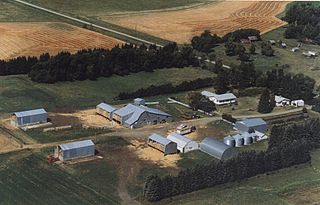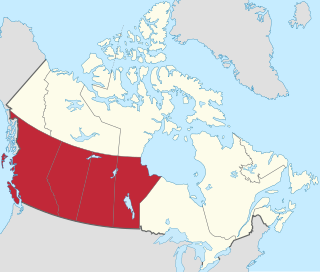
The University of Manitoba is a Canadian public research university in the province of Manitoba. Founded in 1877, it is the first university of western Canada.

Events from the year 1881 in Canada.

Events from the year 1907 in Canada.

The Canadian Prairies is a region in Western Canada. It includes the Canadian portion of the Great Plains and the Prairie Provinces, namely Alberta, Saskatchewan, and Manitoba. These provinces are partially covered by grasslands, plains, and lowlands, mostly in the southern regions. The northernmost reaches of the Canadian Prairies are less dense in population, marked by forests and more variable topography. If the region is defined to include areas only covered by prairie land, the corresponding region is known as the Interior Plains. Physical or ecological aspects of the Canadian Prairies extend to northeastern British Columbia, but that area is not included in political use of the term.

The music of the Canadian Prairies includes the music of the Prairie Provinces of Manitoba, Saskatchewan and Alberta.

The University of Winnipeg is a public research university in Winnipeg, Manitoba, Canada. It offers undergraduate programs in art, business, economics, education, science and applied health as well as graduate programs. UWinnipeg's founding colleges were Manitoba College and Wesley College, which merged to form United College in 1938. The University of Winnipeg was established in 1967 when United College received its charter.
In Canada, the Regional Development Agencies (RDA) are the seven federal government agencies responsible for addressing key economic challenges and furthering economic development, diversification, and job creation specific to their respective regions.

The Alberta Legislature Building is located in Edmonton and is the meeting place of the Legislative Assembly of Alberta and the Executive Council of Alberta. It is often shortened to "the Ledge".

Providence University College and Theological Seminary is an interdenominational Evangelical Christian university college and theological seminary located approximately 50 kilometres southeast of Winnipeg in Otterburne, Manitoba.

Manitoba is one of Canada's 10 provinces. It is the easternmost of the three Prairie provinces.
Raymore is a town in the Canadian province of Saskatchewan, located 110 km north of Regina.
Canadian liquor plebiscites, held in 1920 under the Canada Temperance Act and the Dominion Elections Act, were referendums on the strengthening of the Prohibition measures in effect in several provinces of Canada. Voters were asked if they supported banning of importation of liquor across provincial boundaries. The referendums were held on July 10, 1920, in New Brunswick; on October 20 in British Columbia; and on October 25 in Alberta, Manitoba, Nova Scotia, and Saskatchewan.
The Western Canadian Music Awards (WCMAs) are an annual awards event for music in the western portion of Canada. The awards are provided by the Western Canada Music Alliance, which consists of six member music industry organizations from British Columbia, Alberta, Saskatchewan, Manitoba, Yukon, and The Northwest Territories.

Western Canada, also referred to as the Western provinces, Canadian West or the Western provinces of Canada, and commonly known within Canada as the West, is a Canadian region that includes the four western provinces just north of the Canada–United States border namely British Columbia, Alberta, Saskatchewan and Manitoba. The people of the region are often referred to as "Western Canadians" or "Westerners", and though diverse from province to province are largely seen as being collectively distinct from other Canadians along cultural, linguistic, socioeconomic, geographic, and political lines. They account for approximately 32% of Canada's total population.

Robertson College is a private Canadian career training institution headquartered in Winnipeg, Canada. Robertson has campus locations in Winnipeg in Manitoba and Edmonton and Calgary in Alberta. Robertson offers diploma and certificate programs.

The Princess Theatre is a two-screen art-house cinema located at 10337 Whyte Avenue in Edmonton's historic Old Strathcona neighbourhood. The building was designed by prominent Edmonton architects Wilson and Herrald, a firm responsible for the design of many other Edmonton heritage sites. It became Edmonton's oldest surviving theatre after the demolition of the Gem Theatre in 2006. The building currently houses the main 400-seat theatre as well as the 100-seat Princess II, located in the basement.
The Canadian Western Jewish Times, established in 1914, was the first Jewish newspaper published in English in Western Canada and the earliest attempt to produce a Western Canadian regional Jewish newspaper in English. Like many other efforts to publish Jewish newspapers in Canada between 1891 and the first decades of the 20th century, it proved to be ephemeral.
The University of Alberta Library is the library system of the University of Alberta.

Bruce Peel Special Collections is a library in the University of Alberta Library system that includes more than 100,000 rare books and archival materials. The library is named for Bruce Braden Peel, chief librarian at the University of Alberta from 1955 to 1982.












